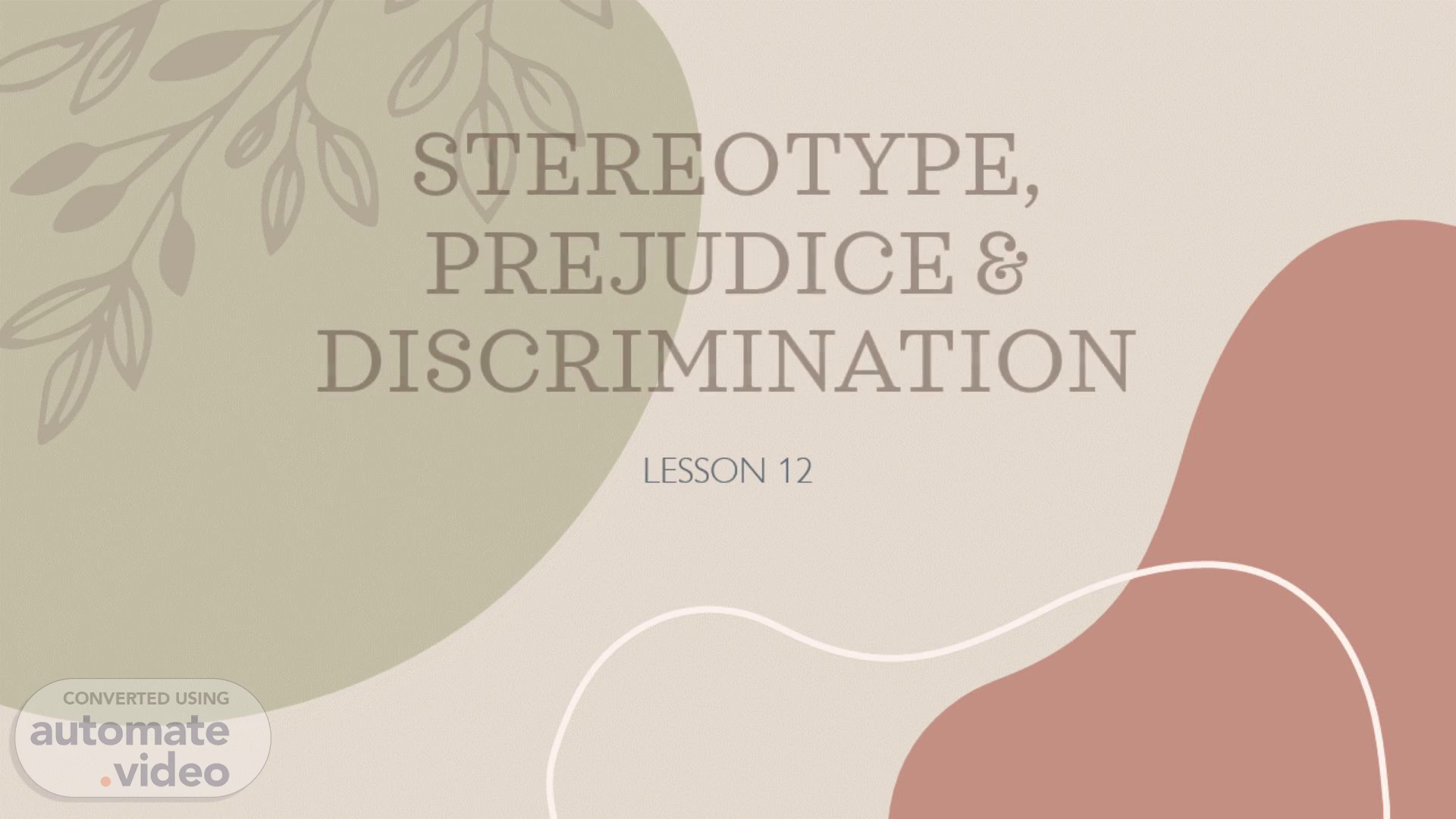
STEREOTYPE, PREJUDICE & DISCRIMINATION
Scene 1 (0s)
STEREOTYPE, PREJUDICE & DISCRIMINATION. LESSON 12.
Scene 2 (6s)
agenda. Gender stereotypes are promoted by parents and teachers, says Stanford University study - India Today.
Scene 3 (12s)
Objectives. Differentiate stereotype, prejudice, and discrimination Understand the manifestation of stereotypes, prejudice, and discrimination on gender. Definitions of Terms Stereotype – Extremely generalize belief about a group of people Prejudice – Unjustified or incorrect attitude towards a person. Discrimination – When stereotypes and prejudice translate into a negative act towards a person..
Scene 4 (29s)
Introduction. There are 7.7 billion people across 195 countries and every race has their own belief, system, religion and culture, and tradition. Yet, each individuals is a unique mis of their own..
Scene 5 (44s)
Stereotypes.
Scene 6 (49s)
Stereotypes. Stereotypes are an “ over- generalized belief about a particular group or class of people” (Cardwell 1996). It can be helpful in simplifying things, after all, there are 7.7 billion people in the planet. While some stereotypes convey positive example (UP students would be stereotypes convey as very intelligent or matalino, or Filipinos being known for our hospitality..
Scene 7 (1m 9s)
Stereotypes. Most stereotypes, however, are drawn from negative generalization like equating our Muslim countrymen as terrorist and viewing farmers and blue collars workers as lazy and less educated. A stereotype can be categorized as “ explicit”, meaning the person is aware that they have these thoughts toward a group of people as they can say it out loud. It can also be “implicit” wherein the person does not know if they have these stereotypes since it lies in their subconscious..
Scene 8 (1m 32s)
Gender Stereotype. 20XX. presentation title. 8.
Scene 9 (1m 39s)
Prejudice. Prejudice is and “unjustified or incorrect attitude (usually negative) towards an individual. The negative attitude (prejudice) can be dangerous since it often leads to negative action and behaviors. For example, a sexist person is someone who has attitude towards the other sex and sees them as the lesser sex. This attitude could manifest into action such as bullying, discriminations, or violence..
Scene 10 (1m 59s)
Prejudice Example. Ageism Someone is too old or too young to work in a particular role or activity..
Scene 11 (2m 27s)
Discrimination. Discrimination refers to action or behaviors towards and individual or a group of people. People who are discriminated on are treated worse than the way people are usually treated just because they belong to a certain group or they have certain characteristics..
Scene 12 (2m 42s)
Genocide. Genocide is the action recognizing someone as different so much that they are treated inhumanly and degraded. Ex. The Holocaust, the Nazi genocide of 6 million European jews during World War II..
Scene 13 (2m 55s)
Apartheid. Is a form of racial discrimination wherein one race is viewed as less than the other. Ex. separation of black and whites..
Scene 14 (3m 6s)
Gender Discrimination. Is another common form of discrimination. Statistically women earn less than men and are often relegated to be solely responsible form of child- rearing and house chores Men on the other hand, are discriminated in household responsibilities..
Scene 15 (3m 20s)
LGBT Discrimination. LGBT people are treated as lesser than straight people. Discrimination happens early in their childhood as they get bullied when they act differently or dress differently than other kids. During adolescence, they get judged, bullied or physically assaulted as they explore and express their sexuality..
Scene 16 (3m 36s)
Freedom and Equality. Article I of the Universal Declaration of Human Rights (UDHR) states that “ all human beings are born free and equal in dignity and rights” Its preamble recognize that the “inherit dignity and of the equal and inalienable rights of all members of the human and family is the foundation of freedom, justice, and peace in the world”.
Scene 17 (3m 56s)
Freedom and Equality. While discriminatory traditions, policies, ideas and practices and laws exist in many countries , many have shifted towards, making opportunities and privileges accessible to everyone. Ex. In the Philippines all establishment are now required by law to have an access ramp for people with disabilities. Appreciating diversity of the human race is key to making a safer and more inclusive environment for everyone, regardless of sex, religion, sexuality, gender or creed..
Scene 18 (4m 18s)
thank you.